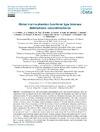Identificador persistente para citar o vincular este elemento:
https://accedacris.ulpgc.es/jspui/handle/10553/51631
| Título: | Global marine plankton functional type biomass distributions: Coccolithophores | Autores/as: | O'Brien, Colleen J. Peloquin, Jill A. Vogt, Meike Heinle, Moritz Gruber, Nicolas Ajani, Penelope Andruleit, H. Arístegui, J. Beaufort, L. Estrada, M. Karentz, D. Kopczyńska, Elzbieta E. Lee, R. Poulton, Alex J. Pritchard, T. Widdicombe, Claire |
Clasificación UNESCO: | 251001 Oceanografía biológica | Palabras clave: | Emiliania-Huxleyi Indian-Ocean Cell-Volume Carbon Dynamics, et al. |
Fecha de publicación: | 2013 | Editor/a: | 1866-3508 | Publicación seriada: | Earth System Science Data | Resumen: | Coccolithophores are calcifying marine phytoplankton of the class Prymnesiophyceae. They areconsidered to play an import role in the global carbon cycle through the production and export of organiccarbon and calcite. We have compiled observations of global coccolithophore abundance from several existingdatabases as well as individual contributions of published and unpublished datasets. We make conservativeestimates of carbon biomass using standardised conversion methods and provide estimates of uncertainty as-sociated with these values. The quality-controlled database contains 57 321 individual observations at varioustaxonomic levels. This corresponds to 11 503 observations of total coccolithophore abundance and biomass.The data span a time period of 1929–2008, with observations from all ocean basins and all seasons, and atdepths ranging from the surface to 500 m. Highest biomass values are reported in the North Atlantic, with amaximum of 127.2μg C L−1. Lower values are reported for the Pacific (maximum of 20.0μg C L−1) and IndianOcean (up to 45.2μg C L−1). Maximum biomass values show peaks around 60◦N and between 40 and 20◦S,with declines towards both the equator and the poles. Biomass estimates between the equator and 40◦N are be-low 5μg C L−1. Biomass values show a clear seasonal cycle in the Northern Hemisphere, reaching a maximumin the summer months (June–July). In the Southern Hemisphere the seasonal cycle is less evident, possiblydue to a greater proportion of low-latitude data. The original and gridded datasets can be downloaded fromPangaea | URI: | https://accedacris.ulpgc.es/handle/10553/51631 | ISSN: | 1866-3508 | DOI: | 10.5194/essd-5-259-2013 | Fuente: | Earth System Science Data [ISSN 1866-3508], v. 5, p. 259-276 |
| Colección: | Artículos |
Citas SCOPUSTM
61
actualizado el 08-jun-2025
Citas de WEB OF SCIENCETM
Citations
57
actualizado el 08-jun-2025
Visitas
77
actualizado el 24-ene-2024
Descargas
90
actualizado el 24-ene-2024
Google ScholarTM
Verifica
Altmetric
Comparte
Exporta metadatos
Los elementos en ULPGC accedaCRIS están protegidos por derechos de autor con todos los derechos reservados, a menos que se indique lo contrario.
